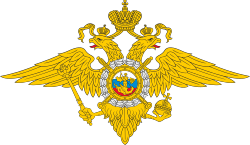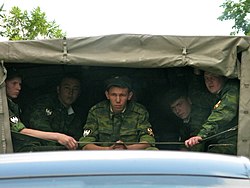This article needs to be updated.(April 2016) |
This article needs additional citations for verification .(September 2013) |
| Internal Troops of the Ministry of Internal Affairs of the Russian Federation Внутренние войска Министерства внутренних дел Vnutrenniye voyska Ministerstva vnutrennikh del | |
|---|---|
 Emblem of Ministry of Internal Affairs and Internal Troops of Russia [2] | |
 Flag of Internal Troops: a 2:3 white flag with rose madder cross pattée and emblem of Internal Troops in the center of it [4] | |
| Common name | Internal Troops |
| Agency overview | |
| Formed | October 20, 1991 |
| Preceding agencies |
|
| Dissolved | April 5, 2016 |
| Superseding agency | National Guard |
| Employees | 182,000 in 2012 [5] |
| Jurisdictional structure | |
| Federal agency | Russia |
| Operations jurisdiction | Russia |
| Governing body | Ministry of Internal Affairs |
| General nature | |
| Operational structure | |
| Headquarters | Moscow |
| Agency executive |
|
| Notables | |
| Anniversary |
|
The Internal Troops of the Ministry for Internal Affairs of the Russian Federation (Russian : Внутренние войска Министерства внутренних дел (ВВ МВД), romanized: Vnutrenniye voyska Ministerstva vnutrennikh del (VV MVD)) was a paramilitary force of the Ministry of Internal Affairs of Russia from 1991 to 2016.
Contents
- History
- Internal Troops of the Russian Empire
- Internal Troops of the Soviet Union
- Russian Internal Troops
- Legal basis
- General organisation
- Districts and formations
- Commanders-in-Chief
- Missions
- Equipment
- Helicopters
- Transportation
- Weaponry
- Shoulder patches
- See also
- References
- Further reading
- External links
The Internal Troops was a gendarmerie-like force that supported the Russian police, dealt with crowd control during riots and internal conflicts, and guarded highly-important facilities such as nuclear power plants. The Internal Troops was involved in all conflicts and violent disturbances in modern Russia, including the First and Second Chechen Wars, where it fell under direct military command during wartime and fulfilled missions of local defence and rear area security. The Internal Troops consisted of both volunteers and conscripts, which caused the number of active service members to fluctuate, with less than 200,000 upon their disestablishment from a peak strength of 350,000, and had experienced a shortage of officers since 1998. The final commander-in-chief of the Internal Troops was Colonel General Viktor Zolotov from 2014 to 2016.
The Internal Troops claimed descent from the Special Corps of Gendarmes of the Russian Empire founded in 1811 and entered their modern form as a paramilitary of the interior ministry of the Russian Soviet Federative Socialist Republic in 1918. It was formed from the Russian branch of the Internal Troops of the Soviet Union in 1991 shortly before the dissolution of the Soviet Union. On 5 April 2016, the Interior Troops was officially split from the Ministry of Internal Affairs to form the basis of the National Guard of Russia. [6] [7]



















